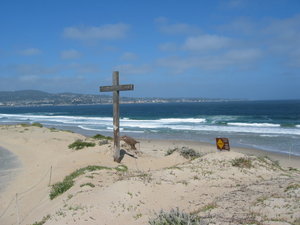Advertisement
Published: April 6th 2009

 PORTOLA'S CROSS
PORTOLA'S CROSS
Site of Portola's cross on Monterey Beach(Excerpted from my book Our Summer In Carmel. Amazon.com)
It is difficult today to understand why it took Spain 160 years to follow-up on Vizcaino's groundbreaking exploration. It is true that Spain was preoccupied with European conflicts. They were also receiving a great amount of treasure from the possessions they already acquired in the new world. Even great nations can get complacent. Finally, it was no easy task for Spain to manage the already vast empire of New Spain, much less occupy a huge new territory such as Alta California that seemed to have little promise of yielding additional wealth to the King's treasury. Two developments finally forced Madrid to reassess their position regarding Alta California. Russia had established a strong foothold in Alaska to capitalize on the valuable fur trade, and was also expanding hunting forays and establishing a national presence through colonies in present day northern California. If that wasn't enough the English were so successful in colonizing the Atlantic Coast that they too were considering similar prospects on northern California and present day western Canada. Another factor that would have a historic impact on Spain's awakening interest in Alta California, was King Charles IIIs loathing of the
independent-minded Jesuits. He was determined to replace them with the more amenable Franciscans and turn over to them the fourteen missions the Jesuits had already established in Baja California. There happened to be a Franciscan missionary of great zeal and administrative excellence already in Mexico, a man of humble manner but great tenacity, who only needed to be called to do the King's bidding; Fr. Junipero Serra. Serra had arrived in Mexico in 1749 at the age of 36, labored assiduously for eight years in the Sierra Gorda mountains and created an orderly administration of five missions. His work done he semi-retired waiting for more challenging work. Ten years would pass but events were under way to call him back to even greater service. Another major actor in the unfolding drama was Visitor-General Jose de Galvaz, appointed to replace the Jesuits by King Charles III. He selected Serra to lead the missions in the Baja and ask him to report to Captain Gaspar de Portola then residing at the mother mission in Loretto. Unexpectedly a courier from the Viceroy of New Spain brought word that the Russians were moving south from Alaska and would likely try to establish a trading post at Monterey. Something had to be done. At a meeting of all the actors on May 16, 1768 at San Blas it was decided to organize a colonizing mission to Monterey. Portola would be in command and Serra would establish a new chain of missions to consolidate Spain's presence. It took another year to prepare the expedition but on May 15, 1769 Portola set out for present day San Diego by land and dispatched his ships with additional provisions to met him there. It took Portola 41 days to reach San Diego only to find that of the 90 men who set sail only fourteen had arrived safely, and most of them were sick. Furthermore, most of the provisions had been consumed. Courageous and persistent Portola decided to press forward. He sent one ship back for resupply, left Serra to care for the wounded, and instructed them to meet him later in Monterey; he was going by land through a trackless wilderness. Unfortunately Portola took a route north along the rugged coast. Had he gone inland he would have followed the easier route of present day highway 101. Coming to the Salinas river the party made their way to the coast, but became confused. Portola had in fact arrived at Monterey, but failed to recognize it. Moreover the provision ship failed to arrive. With winter setting in, his party exhausted, and almost out of provisions Portola determined he had to return to San Diego and regroup. In case the provision ship did arrive, Portola erected a cross and left a note in a bottle at its base, fearing that none of his party would survive. It read, "The land expedition is returning to San Diego for lack of provisions, today Dec. 9, 1769." They were exactly where they wanted to be, but did not recognize it. The survivors staggered into San Diego on January 14, 1770 having traveled 1000 miles through a forbidding, trackless wilderness with nothing accomplished. Portola does not give up. The rest of the story in the next post.
Advertisement
Tot: 0.349s; Tpl: 0.009s; cc: 8; qc: 40; dbt: 0.0524s; 1; m:domysql w:travelblog (10.17.0.13); sld: 1;
; mem: 1.4mb

 PORTOLA'S CROSS
PORTOLA'S CROSS
 PORTOLA'S CROSS WITH PLAQUE
PORTOLA'S CROSS WITH PLAQUE